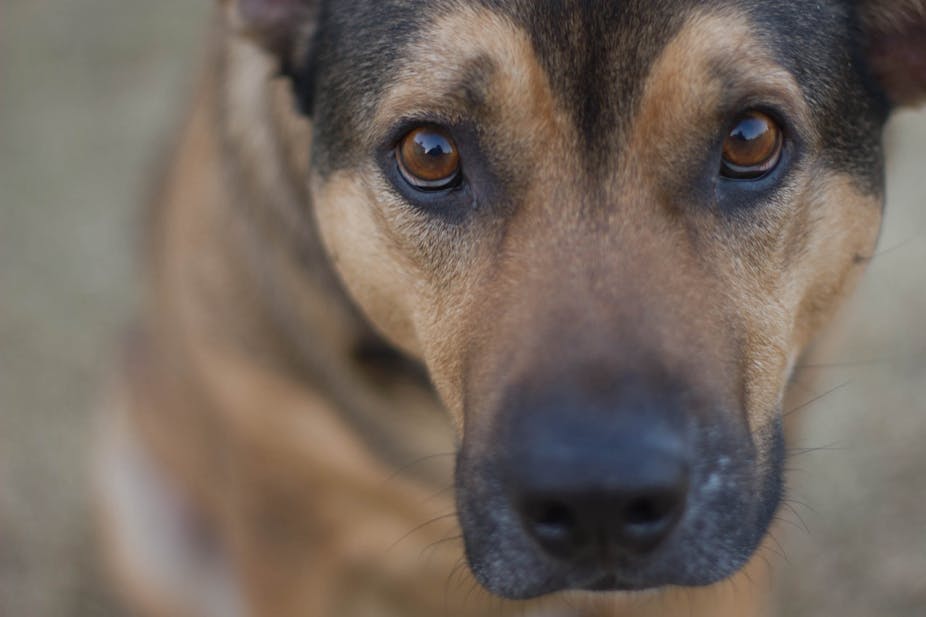When we talk about violence, there is an implicit assumption that we mean human-to-human violence. Yet behind the veneer of our civilised society, economy and culture is a massive edifice of violence of an almost unimaginable scale: the violence of humans towards animals.
This violence does not just affect animals as victims but has widespread impact on humans. There is now a field of research that addresses the link between human and animal directed violence. The idea that underpins “the link” is that deliberate violence to animals is related to a propensity for violence more generally.
There have, for instance, been a number of studies that link the abuse of animals in childhood with subsequent human abuse later in life. University of South Carolina researcher Clifton Flynn has demonstrated that childhood experience of the abuse of other animals is common. Cats, dogs, rodents, birds and reptiles were the most common victims, and the most common methods of abuse were shooting, hitting, beating, kicking, or throwing an animal against the wall.
In a 2002 study, Fiona Becker and Lesley French highlighted four main themes that run through this body of research:
- animal abuse as part of the continuum of abuse within the family
- animal abuse perpetrated by children who show later aggressive and deviant behaviour
- animal abuse as an indicator of child abuse
- therapeutic potential of animals in child development and within post-abuse work.
This research has tended to treat violence towards animals only as an indicator of violence in human-to-human relationships, rather than being significant in itself.
It has treated such violence as aberrant, even criminal behaviour, which requires identification, treatment and possibly punishment. This approach allows us to ignore the more systematic violence which underpins our daily life and which is largely hidden from view.

By far the greatest violence perpetrated by humans on animals is the violence, which is legal, sanctioned and institutionalised – such as when we use animals for entertainment, scientific research and, most significantly, when we turn animals into food.
Every year, 60 billion animals worldwide are killed for food. This figure includes 9 million in Australia, 900 million in the UK and 10 billion in the US. These figures do not include marine life or wild and feral animals killed by hunters or those who die through displacement and loss of habitat.
Add to this the 50 million animals killed every year for fur and the 100 million who die through vivisection in laboratories.
In Australia, it has been estimated that 250,000 heathy cats and dogs are destroyed each year due to overbreeding and lack of willing homes. We have no figures on the young and healthy greyhounds killed because they don’t run fast enough. Many forms of entertainment involving animals are inherently violent.
Rodeos in particular are a violent spectator sport where bulls, horses and calves are provoked into “wild” behaviour through the use of devices such as spurs, electric prods and flank straps. Rodeo animals suffer many kinds of injuries and are sometimes killed or have to be destroyed. While banned in the UK, and in parts of Europe and the US, they are popular in Australia.

In terms of wildlife, Australia allows the largest commercial slaughter of land-based wildlife on the planet. In the past 20 years, it is conservatively estimated that 90 million kangaroos and wallabies have been lawfully killed for commercial purposes.
A recent report also finds that some 440,000 dependent young kangaroos are either clubbed to death or left to starve after their mothers are killed.
We also know that at least 800,000 “bobby calves” are sent to slaughter each year at about five-days-old as a hidden by-product of the dairy industry, but the figure is likely to be greater as many are killed as newborns on the farm.
On-farm violence to animals is not something we like to think about, but it is part of everyday working life. Sheep are mulesed, dairy cows (mainly in Victoria) have their tails cut off, male animals are castrated, cows may have their horns cut off, pigs have their tails and teeth cut and chickens have their beaks cut.
Animals are crammed together in unnatural conditions on factory farms, unable to express their natural behaviours. Transportation and slaughter are intrinsically violent with many animals injured or killed in transit and many inadequately stunned at the time of slaughter.
This is violence to our fellow creatures on a scale unprecedented in the history of the planet. How is it that we continue to think of ourselves as good, kind and moral people when this violence is played out every day in our name and for our benefit?
We are able to do this, to a greater or lesser degree, through a complex and socially pervasive process of denial.
Elsewhere I have shown that we live in a state of denial about violence to animals which is both personal and social. Stanley Cohen argues that whole societies may slip into collective denial without either public sanctions or overt methods of control.
Denial can be defined as “the maintenance of social worlds in which an undesirable situation (event, condition, phenomenon) is unrecognized, ignored, or made to seem normal”.
Denial becomes necessary when truth is confronting and liable to cause distress. In relation to the way animals are treated today, denial is a powerful force, which is mediated and reinforced by political institutions, in turn influenced by the marketing power of the meat and livestock industries.
Denial, and the silence surrounding it, allows most people to believe that they are compassionate and non-violent and even that they “love” animals - at the same time as they want to eat them. In this process violence is done, and done on a monumental scale. Will we ever fully include animals in our moral universe?
Over the coming months, we’ll be running pieces looking at the history and nature of violence.

